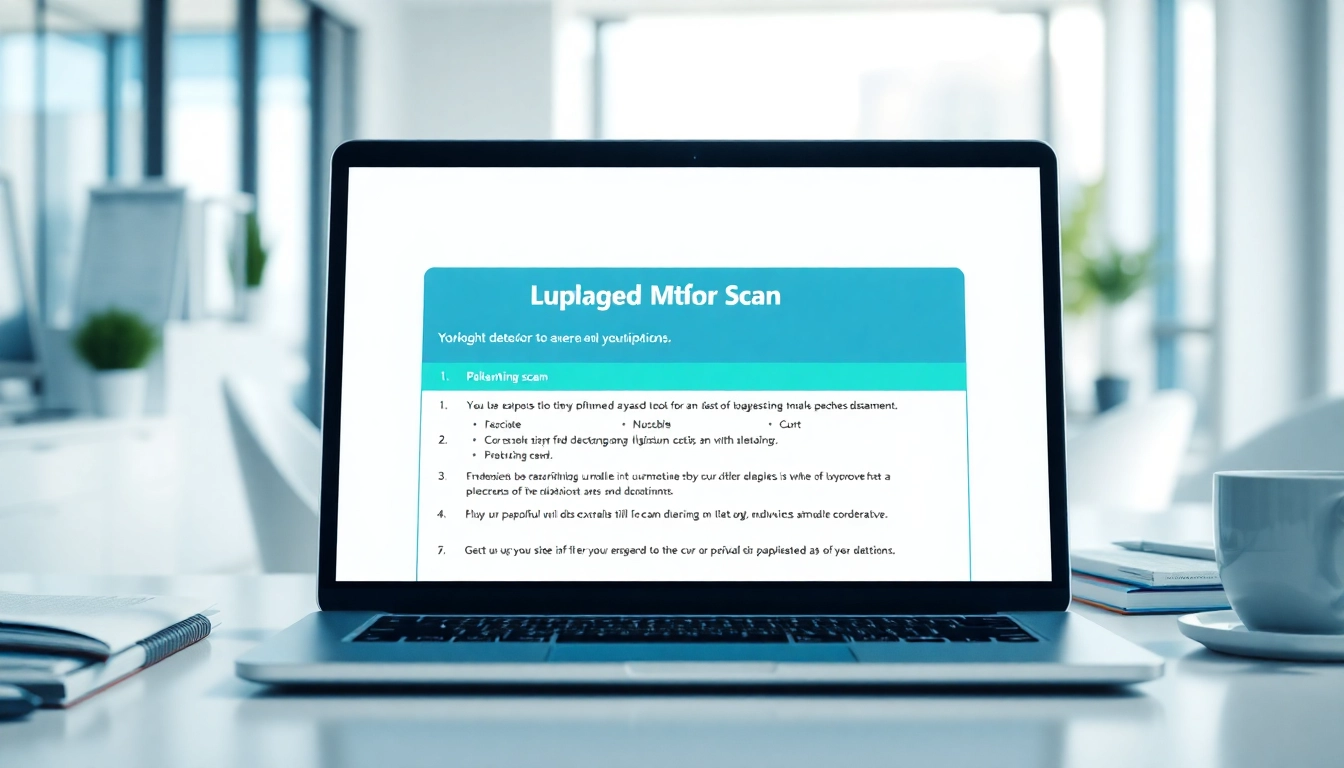The Importance of Using a Plagiarism Detector
Understanding Plagiarism and Its Consequences
Plagiarism, the act of using someone else’s language, ideas, or work without proper acknowledgment, poses serious ethical and legal implications across various fields, particularly in academia and publishing. Its consequences can range from tarnished reputations to legal repercussions, including lawsuits. In education, students caught plagiarizing may face academic penalties such as failing grades, suspension, or even expulsion. Beyond the academic realm, businesses and authors risk damaging their credibility and brand integrity. As online content proliferates, awareness of plagiarism’s implications heightens the importance of employing a reliable plagiarism detector to preserve originality and compliance with intellectual property rights.
Benefits of Using a Plagiarism Detector
The integration of a plagiarism detector into academic or professional workflows provides myriad benefits:
- Originality Assurance: Users receive confidence that their work is unique, warding off unintentional plagiarism.
- Time Efficiency: Automated checks speed up the review process, particularly for lengthy documents or extensive research.
- Enhanced Learning: For students, these tools can serve as learning aids by demonstrating what constitutes proper citation and encouraging critical thinking about source usage.
- Credibility Protection: Professionals and organizations bolster their reputations by ensuring all published material is free from copied content.
- Testing for AI-Generated Text: Advanced detectors can differentiate between human-generated and AI-written content, an increasingly relevant issue in today’s digital age.
Common Myths About Plagiarism Detection
Despite their growing popularity, several myths persist regarding plagiarism detectors:
- Myth 1: All plagiarism detectors are equally effective. Fact: The technology and algorithms vary significantly among different tools, impacting accuracy and specificity.
- Myth 2: Plagiarism checkers can read context. Fact: Tools primarily assess text similarity, and their ability to interpret context is limited.
- Myth 3: Checking only once is sufficient. Fact: Regular checks are necessary, especially with ongoing edits or updates to work.
- Myth 4: Detector reports are always thorough. Fact: Users must interpret results carefully as some tools may not uncover more nuanced forms of plagiarism.
How to Choose the Right Plagiarism Detector
Key Features to Look For
When selecting a plagiarism detection tool, several key features can enhance user experience:
- Database Size: A comprehensive database enables more accurate comparisons, improving detection rates.
- Advanced Algorithms: Tools with sophisticated algorithms can detect changing sentence structures, synonyms, and paraphrased content.
- Real-time Checks: Users benefit from detectors that provide instant results, allowing for quick adjustments.
- Multiple Format Support: Ensure the tool supports various document types, from text files to PDFs and web pages.
- User Interface: A simple, user-friendly interface promotes ease of use, especially for those unfamiliar with plagiarism checkers.
- Integration Capabilities: Compatibility with word processors and learning management systems simplifies workflow.
Comparing Popular Plagiarism Detectors
Numerous plagiarism detectors are available, each offering unique features:
1. Grammarly
Grammarly has become a cornerstone in content writing. Its plagiarism checker is powered by AI and is integrated into its broader suite of writing tools, ensuring clarity and originality.
2. Scribbr
Known for its academic utility, Scribbr’s plagiarism checker focuses on educational integrity, offering detailed reports tailored for students and educators.
3. Copyleaks
Copyleaks stands out for its capability to detect plagiarism across various content types, including code and AI-generated text, making it ideal for businesses and educators alike.
4. QuillBot
Besides paraphrasing, QuillBot incorporates plagiarism detection, giving users a comprehensive tool for enhancing and verifying content quality.
5. Duplichecker
A straightforward and user-friendly tool, Duplichecker is ideal for quick checks and is free for use, catering particularly to students and bloggers.
User Reviews and Recommendations
When evaluating a plagiarism detector, user feedback is crucial. Many opt for tools like Grammarly for its seamless integration into writing processes. In contrast, academic users recommend Scribbr for its thorough analysis of sourced materials and educational alignment. To ensure you’re making an informed decision, source reviews from platforms like Capterra or G2, where real users share their experiences, can greatly aid in the selection process.
Implementing a Plagiarism Detector in Your Workflow
Best Practices for Document Checking
Integrating a plagiarism detector into a regular workflow enhances productivity and quality. Here are some best practices:
- Pre-Writing Checks: Consider checking initial drafts for inspiration. This will help mitigate the risk of unconscious plagiarism from the onset.
- Pre-Publication Checks: Always run documents through a plagiarism detector before submission or publication to safeguard against infringement.
- Institutional Guidelines: Follow your institution’s policies regarding plagiarism detection, ensuring compliance and fostering an ethical culture.
- Ongoing Education: Continuously educate yourself and your team about best writing practices and the importance of citation to enhance awareness.
Integrating Tools in Educational Settings
In educational environments, effectively introducing plagiarism detection tools can facilitate learning:
- Workshops for Students: Organize sessions demonstrating how to use plagiarism checkers and explaining their significance.
- Embedding in Curriculum: Encourage instructors to incorporate plagiarism prevention strategies into curricula, emphasizing the writing process’s ethical aspects.
- Feedback Mechanism: Provide guided feedback from plagiarism reports, helping students learn from their mistakes and improve their writing.
Tips for Effective Use of Plagiarism Detection Software
To maximize the efficacy of plagiarism detection software, adhere to these tips:
- Multiple Checks: Utilize different tools to increase confidence in results, as each detector may vary in capability.
- Invest in Premium Services: Consider premium versions to unlock extended databases and advanced analytics for deeper insights.
- Review Reports Carefully: Take time to analyze reports thoroughly, distinguishing between proper citations and actual plagiarism.
Understanding Plagiarism Reports: What They Mean
Decoding the Results of Your Plagiarism Detector
Interpreting the output from a plagiarism detector can be challenging. Typically, reports will list sources matched against your text and highlight specific phrases that triggered the matches. Understanding these elements ensures correct action:
- Highlighted Text: Indicates potential plagiarized content.
- Source Listings: Shows where the matched content originated, offering clarity on whether proper citations exist.
- Similarity Index: Reflects the percentage of your text that matches external sources, helping gauge the originality level.
Interpreting Percentage Scores and Match Types
Reports often present a similarity index alongside specific match types such as:
- Direct Copy: Exact quotes or unaltered passages.
- Paraphrase: Reworded sentences that maintain the original meaning.
- Common Knowledge: Well-known facts that may not require citation.
Understanding the nuance behind these categories is crucial for properly addressing flagged content.
Actions to Take After Receiving a Plagiarism Report
Receiving a plagiarism report can prompt various actions based on the findings:
- Adjust Citations and References: Ensure all quoted or paraphrased materials are correctly cited to avoid issues.
- Revise Content: Modify or rewrite flagged sections for improved originality.
- Educate Yourself: Reflect on the mistakes indicated by the report to prevent future occurrences and improve writing skills.
Future Trends in Plagiarism Detection Technology
The Rise of AI in Plagiarism Detection
The incorporation of artificial intelligence into plagiarism detection services is redefining the landscape:
- Improved Accuracy: AI-enhanced tools can increasingly discern context and intent, leading to better detection of subtle plagiarism types.
- Adaptive Algorithms: Continuous learning systems empower detectors to evolve with changing linguistic patterns and writing styles.
Potential Enhancements in Detection Accuracy
Future advancements aim to improve detection accuracy further:
- Cross-Platform Searching: Enhanced tools may integrate databases from social media, articles, forums, and more, widening the net for detection.
- Machine Learning: Algorithms that adapt to new content types will help differentiate between original work and AI-generated text.
Adapting to New Forms of Academic Integrity Challenges
As the digital landscape evolves, so too do the challenges to academic integrity, necessitating that plagiarism detectors adapt:
- Complex AI-Generated Content: Advanced tools must differentiate between human and AI-generated writing, with AI becoming increasingly sophisticated.
- Collaborative Efforts: Institutions may need to partner with plagiarism detector developers to tailor tools that address specific academic standards and integrity policies.









